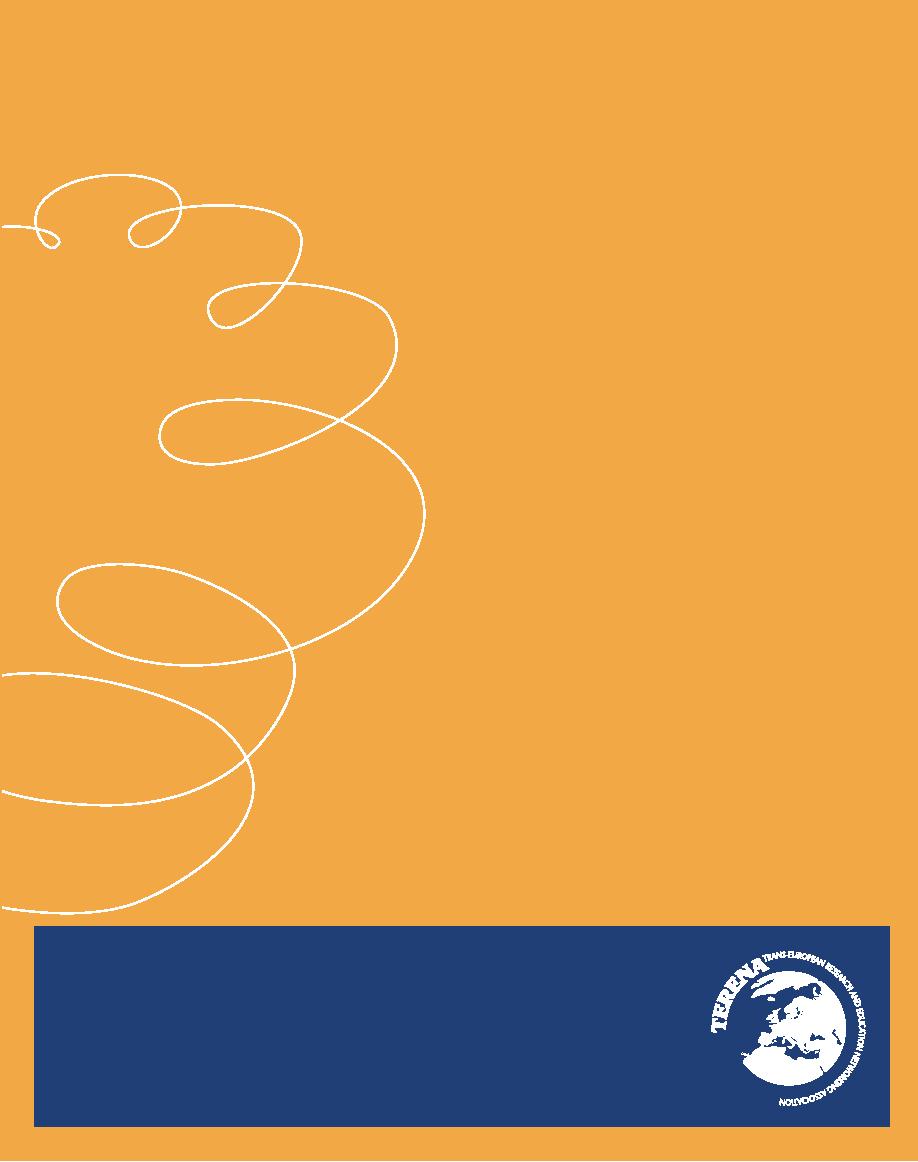 |
CONTENTS |
| INTRODUCTION:Goal, Reasons for writing this document, How to read this document >> |

IP
Telephony Cookbook
>
TERENA REPORT
//
>
/ MARCH, 2004
The
IP Telephony Cookbook was
created through the IP Telephony
project as a reference
document
for setting up IP Telephony solutions at
university campuses and
NRENs.
The
project started in Apr il
2003 and ran until
February 2004. The Cookbook
provides an
overview
of available and future IP
Telephony technologies, scenar ios
for IP Telephony
deployment
and infrastructures, guidelines on
protocols, service set-ups
and connection to a global
`dialling
plan'. Further more,
the Cookbook reports on
the interoperability of
equipment,
existing IP Telephony projects and
regulatory aspects.
The
project was car r ied out by
the University of Pisa, Italy,
TZI-University of Bremen
and
FhG FOKUS, Ger many, with
contr ibutions from CESNET,
GRNET, SURFnet and
the
University of Graz.
Funding
to the project was provided by TERENA,
ARNES, CARNet, CYNET, SUNET
and
UKERNA.
Representatives of the funding
organisations were members of the Project
Review
Committee.
ISBN
90-7759-08-6
TERENA
2004 © All rights
reserved.
Parts
of this report may be freely
copied, unaltered, provided
that the original source
is
acknowledged
and the copyright
preserved.
Production:
TERENA Secretariat
Design:
Eva de Lange
Printing:
GraphicResult
P.2

[IP
Telephony Cookbook] /
Contents
AUTHORS
:
Margit
Brandl - Karl Franzens - UNI
Graz, Dimitris Daskopoulos -
GRNET,
Erik
Dobbelsteijn - SURFnet, Rosario
Giuseppe Garroppo - University of Pisa,
Jan Janak - FhG Fokus,
Jiri
Kuthan - FhG Fokus, Saverio Niccolini -
University of Pisa, Jörg Ott -
Universität Bremen
TZI,
Stefan
Prelle - Universität Bremen
TZI, Sven Ubik - CESNET Uni
Graz, Egon Verharen - SURFnet
P.3
[IP
Telephony Cookbook] /
Contents
CONTENTS
//
1.
INTRODUCTION
7
1.1
Goal
1.2
Reasons
for writing this
document
1.3
Contents
1.4
How
to read this document
1.5
Techno-economic
aspects of moving from
classic telephony to VoIP
2.
TECHNOLOGICAL BACKGROUND
11
2.1
Components
2.1.1
Terminal
2.1.2
Server
2.1.3
Gateway
2.1.4
Conference bridge
2.1.5
Addressing
2.2
Protocols
2.2.1
H.323
2.2.2
SIP
2.2.3
Media gateway control
protocols
2.2.4
Proprietary signalling
protocols
2.2.5
Real Time Protocol (RTP)
and Real Time Control
Protocol (RTCP)
3.
IP TELEPHONY SCENARIOS
52
3.1
Introduction
3.2
Scenario 1: Long-distance least
cost routing
3.2.1
Least cost routing - an
example of an implementation
3.3
Scenario 2: Alternatives to legacy PBX
systems
3.3.1
Scenario 2a: IP Phones
without a PBX system
3.3.2
Scenario 2b: Integration of VoIP
with legacy PBX
systems
3.3.3
Scenario 2c: Full
replacement of legacy PBX
systems
3.4
Scenario 3: Integration of VoIP and
videoconferencing
3.4.1
Integrating voice and
videoconferencing over IP - an
example
4.
SETTING UP BASIC SERVICES
64
4.1
General concepts
4.1.1
Architecture
4.1.2
Robustness
4.1.3
Management issues
4.2.
Dial plans
4.3
Authentication
4.3.1
Authentication in H.323
P.4
[IP
Telephony Cookbook] /
Contents
4.3.2
Authentication in SIP
4.4
Examples
4.4.1
Example 1: simple, use IP
Telephony like legacy
telephony
4.4.2
Example 2: complex,
full-featured
4.5
Setting
up H.323 services
4.5.1
Using a Cisco Multimedia
Conference Manager (MCM
Gatekeeper)
4.5.2
Using a RADVI SION-Enhanced Communication
Server (ECS Gatekeeper)
4.5.3
Using an OpenH.323 Gatekeeper - GNU
Gatekeeper
4.6
Setting
up SIP services
4.6.1
Operation of SIP servers
4.6.2
SIP express router
4.6.3
Asterisk
4.6.4
VOCAL
4.7
Firewalls
and NAT
4.7.1
Firewalls and IP
Telephony
4.7.2
NAT and IP Telephony
4.7.3
SIP and NAT
5.
SETTING UP ADVANCED SERVICES
135
5.1
Gatewaying
5.1.1
Gateway interfaces
5.1.2
Gatewaying from H.323 to
PSTN/ISDN
5.1.3
Gatewaying from SIP to
PSTN/ISDN
5.1.4
Gatewaying from SIP to H.323
and vice versa
5.1.5
Accounting gateways
5.2
Supplementary services
5.2.1
Supplementary services using
H.323
5.2.2
Supplementary services using
SIP
5.3
Multipoint conferencing
6.
SETTING UP VALUE-ADDED SERVICE
173
6.1
Web integration of H.323
services
6.1.1
RADIUS-based methods
6.1.2
SNMP-based methods
6.1.3
Cisco MCM GK API
6.1.4
GNU GK status interface
6.2
Web integration of SIP services
6.2.1
Click-to-dial
6.2.2
Presence
6.2.3
Missed calls
6.2.4
Serweb
6.2.5
SIP express router message
store
6.3
Voicemail
7.
INTEGRATION OF GLOBAL TELEPHONY
184
7.1
Technology
7.1.1
H.323 LRQ
P.5
[IP
Telephony Cookbook] /
7.1.2
H.225.0 Annex G
7.1.3
Telephony routing over IP
(TRIP)
7.1.4
SRV-records
7.1.5
ENUM
7.2
Call routing today
7.2.1
SIP
7.2.2
Using H.323
7.3
Utopia: setting up global IP
Telephony
7.4
Towards Utopia
7.4.1
Call routing
assistant
8.
REGULATORY / LEGAL CONSIDERATIONS
200
8.1
Overall
8.2What
does regulation mean for
Voice over IP?
8.3
Regulation of Voice over IP in
the European Union
8.3.1
Looking back into Europe's
recent history in
regulation
8.3.2
The new regulatory framework
- technological neutrality
8.3.3
The new regulatory framework
- an overview
8.3.4
Authorisation system instead of
licensing system
8.3.5
Numbering
8.3.6
Access
8.3.7
Interconnection
8.3.8
Quality of Service
8.4Voice
over IP in the United
States
8.5Conclusion
and summary
//
ANNEX
A. European
IP Telephony Projects
210
A.1Evolute
A.26Net
A.3Eurescom
P1111 (Next-Gen open Service
Solutions over IP
(N-GOSSIP)
A.4HITEC
A.5The
GRNET/RTS project
A.6SURFWorks
A.7VC
Stroom
A.8Voice
services in the CESNET2
network
//
ANNEX
B. IP
Telephony Hardware/Software
214
B.1Softphones
B.2Hardphones
B.3Servers
B.4Gateways
B.5Testing
B.6Miscellaneous
//
GLOSSARY
226
P.6
Table of Contents:
- INTRODUCTION:Goal, Reasons for writing this document, How to read this document
- TECHNOLOGICAL BACKGROUND:Components, Terminal, Protocols, SIP
- IP TELEPHONY SCENARIOS:Long-distance least cost routing, Integration of VoIP and videoconferencing
- SETTING UP BASIC SERVICES:General concepts, Dial plans, Authentication
- SETTING UP ADVANCED SERVICES:Gatewaying, Accounting gateways, Multipoint conferencing
- SETTING UP VALUE-ADDED SERVICE:Web integration of H.323 services, Web integration of SIP services
- INTEGRATION OF GLOBAL TELEPHONY:Technology, Call routing today,
- REGULATORY / LEGAL CONSIDERATIONS:Regulation of Voice over IP in the European Union, Numbering
- ANNEX A. European IP Telephony Projects:Evolute, SURFWorks, VC Stroom
- ANNEX B. IP Telephony Hardware/Software:Softphones, Hardphones, Gateways
- GLOSSARY:Call Processing Language, Gatekeeper, Media Gateway Control Protocol